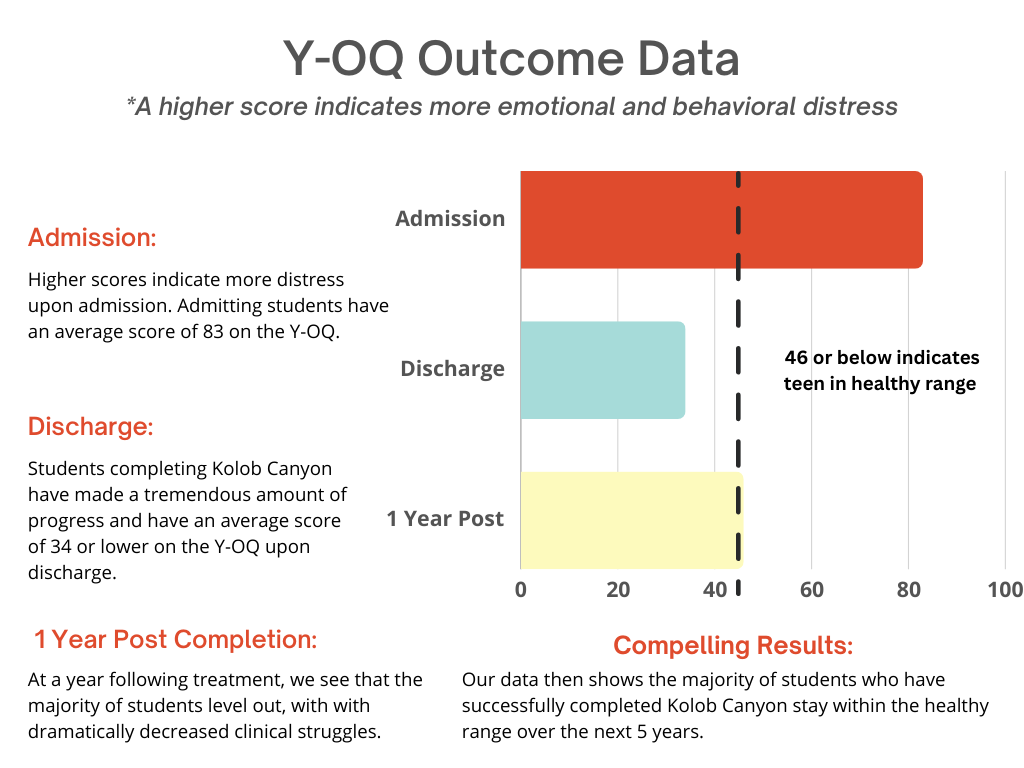Kolob Canyon recognizes the need and responsibility to conduct appropriate research to ensure that our students are receiving the best possible treatment. Kolob Canyon is proud to be designated research based programs through NATSAP (National Association of Therapeutic Schools and Programs). Currently we are actively participating in the NATSAP Outcome Research Project. A formal report of findings from the NATSAP Outcome Research Project can be viewed by clicking on this link:
Explore The Positive Outcomes of Residential Treatment
The National Association of Therapeutic Schools and Programs (NATSAP) recognizes the recent report from the Manhattan Institute as a thoughtful and important contribution to the national conversation on youth mental health and residential treatment. This piece brings needed clarity to the benefits of residential programs while acknowledging areas that demand continued attention and progress. NATSAP supports the growing acknowledgement that residential treatment can and does change lives when delivered with care, oversight, and evidence-based practices. Thousands of families have experienced meaningful healing through therapeutic schools and programs, and this report validates the need to protect and improve those services—not dismantle them.
Families enrolling their teen at Kolob Canyon sacrifice significant time, emotions, and finances in the healing journey. Occasionally we are asked, “How do you know it works?” This is a great question. Success is measured differently by different families. For some, symptom reduction is success. Still others see increased participation in academics as success.
Our main outcome measure is the Youth Outcome QuestionNaire (Y-OQ). The Y-OQ® SR 2.0 is a bi-product of one of the most researched outcome measures for youth in the world, and has been the subject of many studies worldwide. The Y-OQ uses a series of questions to measure the effectiveness of therapeutic treatment. It is designed to reflect the total amount of distress a teen is experiencing. Questions include information about a teen's decision making skills, interpersonal relationships, clinical issues, emotional regulation and mental health history. A higher score indicates more emotional and behavioral distress. A score at or below 46 is within the healthy range.
We ask both parents and their teens to complete the Y-OQ upon admission to our residential programs. While a teen is enrolled at Kolob Canyon, they will complete the YOQ on a regular basis. We then ask both parents and teens to complete it upon discharge/graduation, and again at 12 months post graduation. We have been collecting data since 2007 and now have thousands of data points.
WHAT DO THESE OUTCOME GRAPHS MEAN?
These graphs show a compliation of data from 2024. The dotted line that runs through the graph is indicative of a teen in the healthy range who is not receiving any type of treatment or therapy. The first bar of the graph shows how teens are scoring upon admission, meaning that parents view their children experiencing significant clinical issues including a high degree of behavioral issues, mental health issues and relationship issues. Scoring high on the questionnaire is an indicator that the student is experiencing more struggles.
The second bar illustrates how teens and parents are scoring the teen upon discharge. There is tremendous progress made from admission to discharge. We expect this to happen because a teen has completed extensive treatment in they are at Kolob Canyon. At a year following treatment, we see that the majority of students level out, scoring within the healthy range with dramatically decreased clinical struggles. Our data then shows the majority of students who have attended Kolob Canyon maintain this same level for the next 5 years.
Why Data Collection is a Game-Changer for Mental Health Treatment
When it comes to mental health care, data collection might not sound exciting, but it’s actually a game-changer. Think of it as the secret ingredient that makes treatment more effective and personalized. Here’s why gathering data is so important in mental health and how it’s reshaping patient care for the better.
1. Getting to Know students Better
Data collection helps our therapists get to know their students. By keeping track of things like symptoms, treatment history, and personal background, our teams can understand each student’s unique situation. For example, if a therapist sees a pattern in how often someone’s symptoms change, they can use that information to fine-tune the diagnosis and treatment plan.
2. Tailoring Treatments Just for You
One-size-fits-all doesn’t cut it when it comes to mental health. Data allows therapists to customize treatments based on what’s working for each individual. If data shows that a specific therapy technique is effective for a particular condition, the therapist can use that information to adjust their approach. This means more targeted and effective care for each student.
3. Keeping Track of Progress
Tracking progress is key to successful treatment. Regular data updates let therapists see how well a treatment is working and whether any changes are needed. For example, if a student isn’t responding well to a medication, the data can help guide adjustments to the dosage or suggest trying a different medication. It’s all about making sure the treatment stays on track.
4. Predicting What’s Next
With the help of data, therapists can use predictive tools to anticipate future challenges. By analyzing past data, they can spot patterns and predict things like the chance of a relapse or how well a treatment might work. This helps in planning ahead and making proactive changes to avoid potential issues.
5. Driving Research and New Treatments
Data collection isn’t just for individual care; it’s also crucial for research. Researchers use data to test new treatments, understand mental health disorders better, and discover new ways to help people. The insights gained from data drive innovation and lead to more effective treatments in the future.
6. Improving Quality of Care
For mental health services as a whole, data helps in improving quality. By analyzing patient outcomes and treatment processes, organizations can find out what’s working and what needs improvement. This ongoing evaluation helps ensure that mental health care stays effective and up-to-date.
7. Empowering Patients
Finally, data collection can make our students feel more involved in their own care. When teens see concrete evidence of their progress and understand how their data is being used, they feel more engaged and motivated. This transparency builds trust and encourages better collaboration between students and their therapists.
In Short
Data collection might not be the most glamorous aspect of mental health care, but it’s incredibly important. It helps our therapists understand our students better, personalize treatments, track progress, predict outcomes, advance research, improve care quality, and empower our students.

